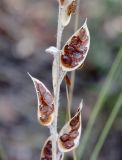
Вскрывшиеся плоды с семенами. Крым, окр. пос. Никита, мыс Мартьян, земляничниково-пушистодубняк. 06.10.2016.
Denis Mirin © 2016
The marker on the map does not indicate the exact coordinates of the plant or lichen.
The marker does only indicate the conditional center of the terrain ("geographic point") where the photo was taken.
Open mapSee also:
Discussion (5)
All photos of taxon (39)
Code of link to photo
| Create: | HTML or BBCode with preview |
| Code for linking on the web: | |
| This is how it will look: |  Fibigia clypeata on the site «Plantarium» |
Text to cite the page
Мирин Д. 2016. Изображение Fibigia clypeata (L.) Medik. // Плантариум. Растения и лишайники России и сопредельных стран: открытый онлайн атлас и определитель растений. [Электронный ресурс] URL: https://www.plantarium.ru/page/image/id/476926.html (дата обращения: 30.12.2025).
Mirin D. 2016. Image of Fibigia clypeata (L.) Medik. // Plantarium. Plants and lichens of Russia and neighboring countries: open online galleries and plant identification guide. URL: https://www.plantarium.ru/lang/en/page/image/id/476926.html (accessed on 30 Dec 2025).
Views: 635Discussion
| Denis Mirin | А может это Fibigia eriocarpa? Они вообще различаются? |
| Anna Malykhina | Формой перегородки? |
| Anna Malykhina | Нет, опушением - вот было обсуждение - https://forum.plantarium.ru/viewtopic.php?id=77518
Эта определена правильно, в Крыму другой нет вроде. |
| Denis Mirin | Это я просто просмотрел галереи обоих видов и засомневался, что этот признак работает (что нет постепенного перехода от одной крайности к другой), т.к. и здесь вроде помимо звёздчатых волосков на швах створок стручочка есть простые волоски (или мне кажется). |
| Andriy Kovalchuk | Вот что по этому поводу писал W. Greuter (отсюда):
Fibigia clypeata subsp. eriocarpa (DC.) Greuter, stat. nov. (≡ Farsetia eriocarpa DC., Syst. Nat. 2: 288. 1821 ≡ Fibigia eriocarpa (DC.) Boiss., Fl. Orient. 1: 258. 1867 ≡ Fibigia clypeata var. eriocarpa (DC.) Thiéb. in Mém. Inst. Egypte 31: 67. 1936) – A, B – 950-1800 m. 5:3042 [10] (det. TC); 25:1272 [6]. Note: I concur with Phitos (in Phitos & al. 2002) who does not consider Fibigia eriocarpa as a species distinct from F. clypeata (L.) Medikus; yet silicula indumentum, the main character that has been used to distinguish the two taxa, is not just “variable” but follows a clear geographical pattern, as previous authors on the Balkan flora have correctly recog-nised (see Hayek 1924-1927, who indicates F. clypeata as occurring in Albania, Bulgaria and Macedonia but F. eriocarpa as growing in Ipiros, Thessaly, and [Central to South] Greece). This distributional pattern, which my study of herbarium material confirms, calls for recognition of the southern taxon at subspecies level. |